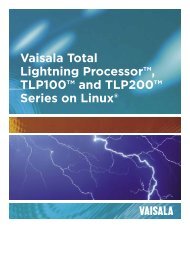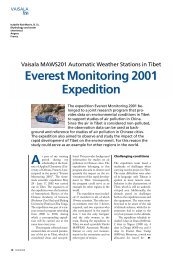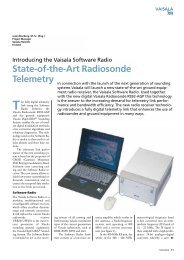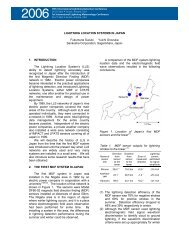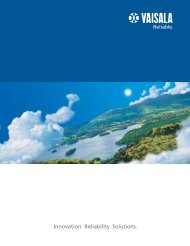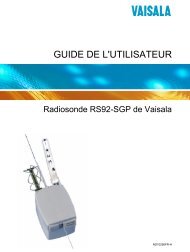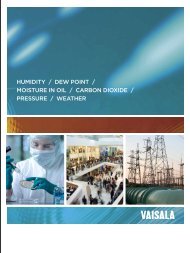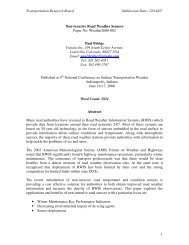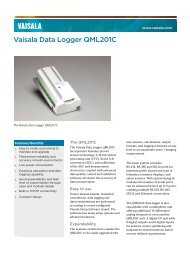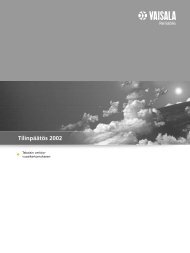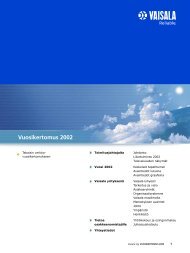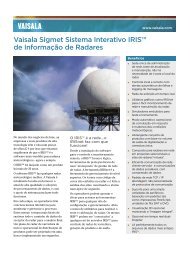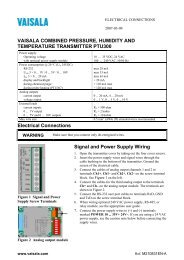Vaisala News 180 - Full Magazine
Vaisala News 180 - Full Magazine
Vaisala News 180 - Full Magazine
You also want an ePaper? Increase the reach of your titles
YUMPU automatically turns print PDFs into web optimized ePapers that Google loves.
Marikka Nevamäki / Editor in Chief / <strong>Vaisala</strong> / Helsinki, Finland<br />
Forecasting<br />
extreme events<br />
of rain<br />
Mr. Vicente Perez and Mr. Santiago<br />
Salson from MeteoGalicia, as well<br />
as Mr. Joaquin Baumela and Mr.<br />
Francisco Torrente from Quatripole<br />
visited <strong>Vaisala</strong> in November<br />
2008. The purpose of the visit was<br />
to carry out Factory Acceptance<br />
Tests (FAT) for the <strong>Vaisala</strong> Weather<br />
Radar WRM200. The radar will be<br />
installed in Galicia, northwestern<br />
Spain, in summer 2009. Meteo-<br />
Galicia is responsible for the local<br />
weather forecasts and warnings in<br />
the Galicia region, and Qatripole is<br />
the local engineering partner for the<br />
installation project. MeteoGalicia<br />
depends on the regional government<br />
of Galicia, Xunta de Galicia. All<br />
their information, also regarding the<br />
new radar products, is available at<br />
www.meteogalicia.es.<br />
The purpose of the FAT tests is<br />
to verify the system performance<br />
against given specifications and<br />
to ensure that all parts of the<br />
system and its documentation exist<br />
according to the purchase order.<br />
Hundreds of <strong>Vaisala</strong> customers from<br />
around the world visit the company<br />
every year to participate in different<br />
FAT tests. It is a great opportunity<br />
for both parties to get to know each<br />
other a little better, and to ensure<br />
mutual understanding of the required<br />
system qualities.<br />
The radar is a part of a weather<br />
observation solution, which <strong>Vaisala</strong><br />
is providing to the region of Galicia.<br />
In addition to the dual-polarization<br />
weather radar, the solution consists<br />
of a lightning detection network<br />
of four sensors and a sounding<br />
system, as well as a five-year service<br />
contract.<br />
Fewer rainy days -<br />
more intensive rain<br />
The Galicia region’s coastal areas in<br />
the west and north are open to the<br />
Atlantic Ocean and its challenging<br />
weather conditions. Severe storms<br />
and thunder are common and cause<br />
damages each year.<br />
“Research on the effects of<br />
climate change has been carried<br />
out in Galicia. It found evidence that<br />
there are more extreme events of rain<br />
in the area than in the past. There<br />
may be fewer rainy days, but when it<br />
rains it is more intensive. There are<br />
clear risks relating to this; villages<br />
and small towns close to rivers or<br />
the sea may suffer damaging floods,”<br />
says Mr. Vicente Perez from Meteo-<br />
Galicia.<br />
“The new <strong>Vaisala</strong> radar<br />
will benefit us in many<br />
ways. It will improve our<br />
capacity for civil protection<br />
as we will be able<br />
to issue more accurate<br />
warnings. The data<br />
gained will compliment<br />
measurement<br />
data from other instruments,<br />
and we will be<br />
From left to right: Joaquin<br />
Baumela, Quatripole and<br />
Santiago Salson Casado and<br />
Vicente Perez Muñuzuri from<br />
MeteoGalicia at the <strong>Vaisala</strong><br />
Factory Acceptance Tests for the<br />
Weather Radar WRM200. <strong>Vaisala</strong>’s<br />
Timo Lyly on the keyboard.<br />
The Spanish region of<br />
Galicia is vulnerable<br />
to extreme weather<br />
events due to its<br />
location by the Atlantic<br />
Ocean.<br />
able to assimilate the information<br />
into our numerical models. The radar<br />
will also be used for more longterm<br />
climatological research. Our<br />
university researchers are already<br />
enthusiastically waiting for the radar<br />
data,” Mr. Perez smiles. “Cyclone<br />
Klaus, which hit the North of Spain<br />
and France in January 2009, is just<br />
one example of a situation where<br />
we could’ve benefited from the new<br />
capabilities offered by this kind of<br />
radar.”<br />
The new and improved weather<br />
observation network can also be<br />
used for providing new kinds of<br />
services to local interest groups<br />
affected by weather, such as fishermen,<br />
shellfish fishermen, clam<br />
pickers, electrical power companies<br />
and recreational agencies. Regional<br />
weather forecasts on TV are also<br />
expected to improve.<br />
<strong>180</strong>/2009 11



